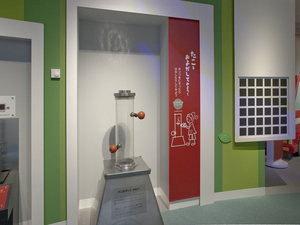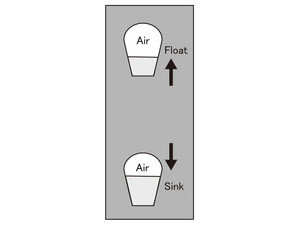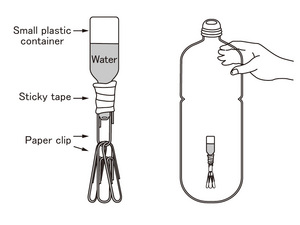Nagoya City Science Museum
TOP > Exhibition Guide > Keyword Search > Starting with "D" > Dancing Octopus > Dancing Octopus
Dancing Octopus



Purpose of Exhibition
Try grabbing the rubber grip strongly and then letting it go. What happens to the octopus in the water? This is an exhibit that applies buoyancy (Archimedes' principle) and Pascal's principle. This exhibit is one of the "Natsukashi no Tenji" (Exhibition from a Good Memory). It has been exhibited since the old Science and Technology building was opened in 1964, and it is the oldest exhibit of all.
Additional Knowledge
[Mechanism of Floating and Sinking]
When grabbing the rubber grip in this exhibit, pressure is transmitted in all directions in the water (Pascal's principle). Although water cannot be squeezed and shrunk, air can. Due to the fact that air is shrinkable, when air in the octopus is compressed, it becomes less buoyant, gets smaller and sinks. When taking your hand off the grip, the pressure is lowered and the air in the octopus fills again, and the octopus floats up. As shown here, changing air volume, floating and sinking an object is called the Cartesian Diver.
By the way, many people know that lifting a heavy object in water is much easier than out of water. This is because when putting an object in water, the force lifting the object upward acts for the weight of volume of the displaced liquid (Archimedes' principle). This force is referred to as buoyancy. Buoyancy acts not only in water, but also in all the liquids and gases. Even in the case of pieces of clay with the same weight, the round one sinks in water, but the boat-shaped clay can be kept afloat. This is because the displaced water volume increases and its buoyancy becomes big. As with the Cartesian Diver, the weight of the entire Cartesian Diver (octopus + air inside) does not change, the displaced water volume varies since the air volume changes. That causes floating and sinking because buoyancy increases and decreases.
[Let's make a Floating and Sinking Toy Octopus.]
(1) Get a small plastic container (like a Japanese fish-shaped soy source container in a sushi plate). Stick a paper clip, giving it weight to sink, on the container with sticky tape. You could color and decorate it. Put some water into the container so that the octopus keeps afloat near the water surface. (We don't use the cap of the plastic container .)(2) Put the octopus (1) in the water bottle filled with water, and cap it tightly so as not to allow any air inside the bottle.
(3) Grab the water bottle hard with your hand and let it go. If the octopus does not float and sink well, adjust the water in the octopus.
Article by Keiko Ishida, curator
